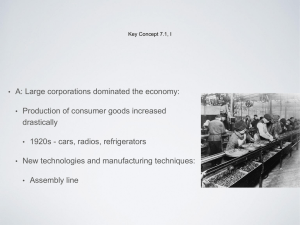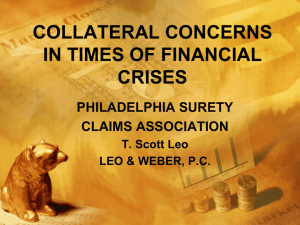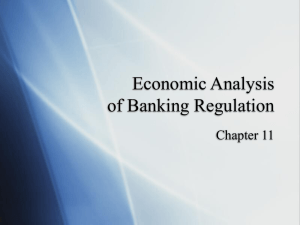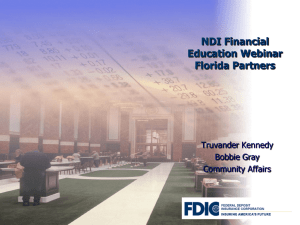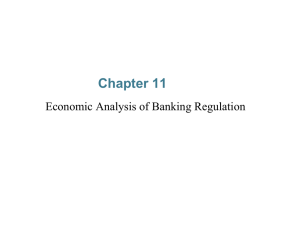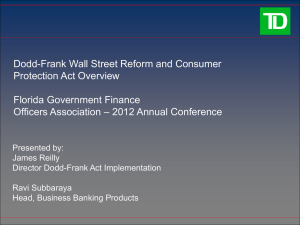Bank Transactions With the FDIC
advertisement
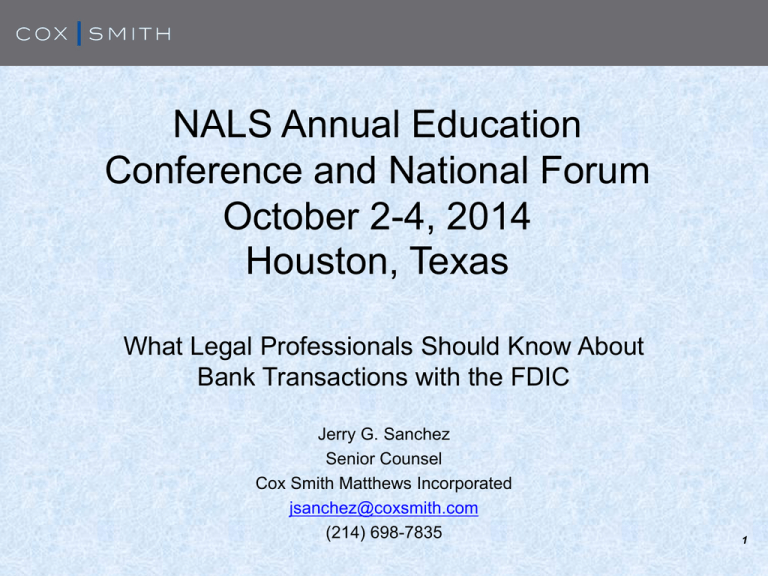
NALS Annual Education Conference and National Forum October 2-4, 2014 Houston, Texas What Legal Professionals Should Know About Bank Transactions with the FDIC Jerry G. Sanchez Senior Counsel Cox Smith Matthews Incorporated jsanchez@coxsmith.com (214) 698-7835 1 Jerry G. Sanchez provides legal and regulatory counsel for banks and finance companies on a variety of consumer finance matters, including compliance with the Truth in Lending Act and Regulation Z, the Truth in Savings Act and Regulation DD, the Equal Credit Opportunity Act and Regulation B, the Fair Credit Reporting Act, the Federal Debt Collection Practices Act, RESPA and Regulation X, the Electronic Funds Transfer Act and Regulation E, affiliated business arrangements, electronic banking and E-commerce, the Fair Debt Collections Practices Act, bank and thrift powers, federal preemption, legal lending limits, Texas home equity law and regulations, Federal and state privacy laws and regulations, fiduciary activities, the USA PATRIOT Act amendments to the Bank Secrecy Act and anti-money laundering regulations, and the Community Reinvestment Act. He prepares and files varied financial regulatory applications and provides advice regarding legal and regulatory issues, including corporate activities. For non-bank entities, Jerry guides clients through state lending license and registration requirements, interest and usury limits, unfair and deceptive trade practices, and state escheat laws. During his tenure at the Federal Deposit Insurance Corporation (FDIC), Jerry G. Sanchez advised management and examiners in an eight state region regarding a wide variety of supervision and consumer compliance legal issues. He represented the FDIC in proceedings involving the imposition of civil money penalties against state-supervised banks, and also advised and represented the FDIC in “outlier” and “non-outlier” actions involving the Equal Credit Opportunity Act and Regulation B claims against state-supervised banks. A graduate of the Southwestern Graduate School of Banking at Southern Methodist University, Sanchez received his J.D. from the University of Texas School of Law and his B.A. degree from the University of Texas at Austin. Sanchez currently serves as Board Secretary for the Dallas-Fort Worth Hispanic Bankers Association and on the Advisory Council for the University of Dallas, School of Ministry, and is also a member of the Dallas Bar Association. 2 History and Structure of the FDIC History and structure of the FDIC: Created in 1933 when President Franklin Roosevelt signed the Banking Act of 1933. Headquartered in the District of Columbia, with six regional offices: Atlanta, Chicago, Dallas, Kansas City, New York City, and San Francisco. Managed by a five-person Board of Directors. Each director is appointed by the President and confirmed by the Senate. No more than three of the directors may be from the same political party. 3 History and Structure of the FDIC Martin Gruenberg is the current Chairman of the FDIC. (See picture below). 4 History and Structure of the FDIC Interesting facts: Since the start of FDIC insurance in 1934, no depositor has lost any insured funds as a result of a bank or thrift institution failure [of course, depositors have lost monies that were in excess of insured amounts]. The FDIC receives no Congressional appropriations; it is funded entirely by premiums banks and thrift institutions pay for deposit insurance coverage and from earnings on investments in US Treasury securities. The FDIC insures roughly $9 trillion in deposits in US banks and thrifts. 5 History and Structure of the FDIC Primary functions: Directly supervises over 4,500 banks and saving banks for operational safety and soundness Examines any bank for compliance with consumer protection laws, including the following, IF state nonmember bank has assets below $10 billion (otherwise the Consumer Financial Protection Bureau (“CFPB”) has supervisory authority): o Fair Credit Billing Act: protects consumers from unfair billing errors and establishes a mechanism for consumers to address billing errors. o Fair Credit Reporting Act: regulates the collection, dissemination, and use of consumer information, including consumer credit information. o Truth-in-Lending Act: designed to promote the informed use of consumer credit, by requiring disclosures about its terms and cost to standardize the manner in which costs associated with borrowing are calculated and disclosed. o Fair Debt Collection Practices Act: seeks to eliminate abusive practices in the collection of consumer debts, to promote fair debt collection, and to provide consumers with an avenue for disputing and obtaining validation of debt information in order to ensure the information's accuracy. 6 History and Structure of the FDIC Examines banks for compliance with the Community Reinvestment Act (“CRA”), which requires banks to help meet the credit needs of the communities they were chartered to serve. Responds to and resolves bank and thrift institution failures. Insures deposit accounts. 7 History and Structure of the FDIC Overview of banking system: Banks may be federally or state chartered. o Federally chartered banks and thrifts are regulated by the Office of the Comptroller of the Currency (“OCC”). o State chartered banks are regulated by the state in which they are chartered plus a federal regulator, depending on whether the bank joins the Federal Reserve. Stated chartered banks that join (“state member banks”) are regulated by the Federal Reserve. State chartered banks that do not join (“state non-member banks”) are regulated by the FDIC. The FDIC examines state non-member banks for operational safety and soundness since their deposits are insured. 8 Deposit Insurance The FDIC insures deposits only What is included? o o o o o Checking Accounts Savings Accounts Money Market Deposit Accounts (“MMDAs”) Certificates of Deposit (“CDs”) Negotiable Order of Withdrawal (“NOW”) Accounts 9 Deposit Insurance What is not included: o Securities o Mutual funds o Bonds o Life insurance o Annuities o Other types of investments that are not deposits (even if purchased from an insured bank) 10 Deposit Insurance What are the FDIC coverage limits? o Single accounts: $250,000 per owner o Joint accounts: $250,000 per co-owner o IRAs and other certain retirement accounts: $250,000 per owner o Revocable trust accounts: $250,000 for each unique eligible beneficiary, subject to certain limitations and requirements 11 Deposit Insurance FDIC’s Electronic Deposit Insurance Estimator: https://fdic.gov/edie/index.html Use Bank Find or call 1-877-ASK-FDIC to verify a bank or savings association is insured by the FDIC 12 FDIC Symbol and Advertisements The FDIC official sign (below) must be displayed at each teller window where insured deposits are accepted Insured depository institutions must state “Member of the Federal Deposit Insurance Corporation,” “Member of FDIC,” or “Member FDIC” in any advertisement promoting deposit products and services 13 Bank Failures A bank may be closed when it becomes critically undercapitalized or is unable to meet its obligations to depositors and others FDIC has two roles in bank failures o Pay insurance to depositors up to the insurance limit o Act as the “receiver” of the failed bank by assuming the task of selling the failed bank’s assets and settling its debts FDIC notifies each depositor in writing by mailing the notice immediately after the bank closes 19 banks have been closed to date in 2014 14 Laws and Regulations Federal Deposit Insurance Act (“FDI Act”) o 12 U.S.C. §§ 1811-1835a o Enacted in 1950 o Sets standards for admission of banks to federal deposit insurance o Authorizes FDIC to pursue enforcement actions o Appoints FDIC as receiver 15 Laws and Regulations FDIC Laws, Rules and Regulations o 12 CFR Parts 301-371 o Advertisement of Membership (Use of “Member FDIC” Logo) o Deposit Insurance Coverage o Establishment, Relocation and Closing of Branches o Merger Transactions o Change in Bank Control o Activities of Insured State Banks o Establishment of Bank Subsidiaries o Section 19 of the FDI Act (Consent to service by persons convicted of certain criminal offenses) o Golden Parachutes and Indemnification Payments 16 Laws and Regulations The FDIC Issues Various Types of Guidance, including : Advisory Opinions FDIC Statements of Policy FDIC General Counsel’s Opinions Financial institution letters 17 Merger Transactions Prior Written Approval Required To: Prior written approval of the FDIC (and other responsible agencies— e.g., OCC, Federal Reserve, state regulator, as applicable), are required for an insured depository institution to— o merge or consolidate with any bank or institution; o assume liability to pay any deposits made in, or similar liabilities of, any bank or institution; or o transfer assets to any bank or institution in consideration of the assumption of liabilities for any portion of the deposits made in such insured depository institution. Prior written approval of a merger transaction is NOT required IF the responsible agency finds that it must act immediately in order to prevent the probable default of one of the banks involved. 18 Merger Transactions o o o o Published Notice: Prior to the FDIC (and other responsible agency) approving a merger, the applicants must publish notice of the proposed merger in a newspaper of general circulation in the community or communities where the main offices of the banks involved are located. Competitive Factors Report Before acting on any application for approval of a merger transaction, the FDIC and responsible agency shall— request a report on the competitive factors involved from the Attorney General of the United States; and Monopolies: The FDIC (and other responsible agencies) shall NOT approve– any proposed merger transaction which would result in a monopoly, or which would be in furtherance of any combination or conspiracy to monopolize or to attempt to monopolize the business of banking in any part of the United States, or any other proposed merger transaction which may be substantially to lessen competition, or which in any other manner would be in restraint of trade, unless it finds that the anticompetitive effects of the proposed transaction are clearly outweighed in the public interest by the probable effect of the transaction in meeting the convenience and needs of the community to be served. In every case, the FDIC (and other responsible agencies) shall take into consideration the financial and managerial resources and future prospects of the existing and proposed institutions, the convenience and needs of the community to be served, and the risk to the stability of the United States banking or financial system (e.g., the deposit insurance fund). 19 Branch Banks No State nonmember insured bank shall establish and operate any new domestic branch unless it shall have the prior written consent of the FDIC; No State nonmember insured bank shall move its main office or any branch from one location to another without such consent. No foreign bank may move any insured branch from one location to another without such consent; No State nonmember insured bank shall establish or operate any foreign branch, except with the prior written consent of the FDIC and upon such conditions and pursuant to such regulations as the FDIC may prescribe. 20 Branch Banks 90 Days Notice to Federal Regulator Identification of Closed Branch Proposed Closing Date Detailed Statement of Branch Closure Reasons Statistical or Other Information Supporting Branch Closing Consistent with Bank’s Branch Closing Policy Copy of Mailed Customer Notice 21 Branch Banks 90 Days Mailed Customer Notice (separate mailing or statement stuffer) 30 Days Lobby Notice (conspicuous location) 22 Institution-Affiliated Parties (“IAPs”) GOLDEN PARACHUTES The FDIC limits, by regulation, certain “golden parachute” payments or indemnification payments. “Golden parachute” payments are large severance payments made by insured banks to its senior executive officers. Indemnification payments reimburse insiders certain expenses, frequently legal costs. The FDIC, by regulation, considers the following factors in determining whether to prohibit golden parachute and indemnification payments: Whether there is a reasonable basis to believe that the IAP has committed any fraudulent act or omission, breach of trust or fiduciary duty, or insider abuse with regard to the depository institution that has had a material affect on the financial condition of the institution. Whether there is a reasonable basis to believe that the IAP is substantially responsible for— o the insolvency of the depository institution; o the appointment of a conservator or receiver for the depository institution; or o the troubled condition of the depository institution, if applicable; 23 Institution-Affiliated Parties (“IAPs”) GOLDEN PARACHUTES Whether there is reasonable basis to believe that the IAP has materially violated any applicable Federal or State banking law or regulation that has had a material affect on the financial condition of the institution. Whether there is a reasonable basis to believe that the IAP has violated or conspired to violate federal criminal or financial laws. Whether the IAP was in a position of managerial or fiduciary responsibility. The length of time the party was affiliated with the insured depository institution and the degree to which— o the payment reasonably reflects compensation earned over the period of employment; and o the compensation involved represents a reasonable payment for services rendered. 24 Institution-Affiliated Parties (“IAPs”) GOLDEN PARACHUTES The term "golden parachute payment" does not include— o any payment made pursuant to a retirement plan which is qualified (or is intended to be qualified) under section 401 of the Internal Revenue Code of 1986 or other nondiscriminatory benefit plan; o any payment made pursuant to a bona fide deferred compensation plan or arrangement which the FDIC determines, by regulation or order, to be permissible; or o any payment made by reason of the death or disability of an IAP. 25 Indemnification Certain Indemnification Payments Prohibited.--No insured depository institution or covered company may prepay the salary or any liability or legal expense of any IAP if such payment is made— in contemplation of the insolvency of such institution or covered company or after the commission of an act of insolvency; and with a view to, or has the result of– o preventing the proper application of the assets of the institution to creditors; or o preferring one creditor over another. 26 Subsidiaries PROCEDURES.--When an insured depository institution seeks to establish or acquire a subsidiary or when a insured depository institution elects to conduct any new activity through a subsidiary that the insured depository institution controls, the insured depository institution— shall notify the FDIC or its primary regulator, as appropriate, not less than 30 days prior to the establishment, or acquisition, of any such subsidiary, and not less than 30 days prior to the commencement of any such activity, and in either case shall provide at that time such information as each such agency may, by regulation, require; and shall conduct the activities of the subsidiary in accordance with regulations of the FDIC or its primary regulator, as appropriate. 27 Deposit Insurance Assessment Rates --Assessed against depository banks whose deposits are insured by the FDIC (up to $250,000 per account). --Based on asset size of depository bank. All rates are annual and are in basis points which are cents per $100.00 of assessment base. --Large and highly complex banks and newly insured depository banks pay higher insurance premiums based on increased risk to FDIC deposit insurance fund. 28 Activities of Insured State Banks Permissible for National Banks? State bank may engage in w/o FDIC approval. Not permissible for National Banks? Prior FDIC approval required. 29 Community Reinvestment Act (“CRA”) The Community Reinvestment Act (“CRA”) is intended to encourage depository institutions to help meet the credit needs of the communities in which they operate, including low- and moderate-income neighborhoods, consistent with safe and sound operations. It was enacted by the Congress in 1977 (12 U.S.C. 2901). CRA encourages banks to not just take deposits from their local communities, but to also make loans. Banks are periodically examined by the FDIC (or other responsible agencies). The agencies exam 3 categories. 30 Community Reinvestment Act (CRA”) Lending Test Investment Test Service Test 31 Community Reinvestment Act (“CRA”) Ratings: Outstanding Satisfactory Needs To Improve Substantial Non-Compliance CRA ratings important for certain regulatory filings by banks, including establishment of branch offices. No satisfactory rating = non-expedited treatment of regulatory filings = non-approval of regulatory filings. By regulation, among other factors, the FDIC takes into account the record of performance under the CRA of each applicant in considering a filing for approval of: o o o o o The establishment of a domestic branch; The relocation of the bank's main office or a domestic branch; The relocation of an insured branch of a foreign bank; A transaction subject to the Bank Merger Act; and Deposit insurance. 32 Conservatorship/Receivership of Insolvent Banks FDIC appointed conservator or receiver of insolvent insured depository banks. Liquidate bank, and sell assets to other banks and financial entities. Pay insured deposits of bank customers (up to $250,000 per account). Pay secured first, and then unsecured creditors only if any monies left. 33 Section 19 of the Federal Deposit Insurance Act (12 U.S.C. 1829) Prohibits, without the prior written consent of the FDIC, a person convicted of any criminal offense involving dishonesty or breach of trust or money laundering (covered offenses), or who has agreed to enter into a pretrial diversion or similar program in connection with a prosecution for such offense, from becoming or continuing as an institution-affiliated party (“IAP”), owning or controlling, directly or indirectly an insured depository institution (insured institution), or otherwise participating, directly or indirectly, in the conduct of the affairs of the insured institution. In addition, the law forbids an insured institution from permitting such a person to engage in any conduct or to continue any relationship prohibited by section 19. Section 19 applies, by operation of law, as a statutory bar to participation absent the written consent of the FDIC. The purpose of an application is to provide the applicant an opportunity to demonstrate that, notwithstanding the bar, a person is fit to participate in the conduct of the affairs of an insured institution without posing a risk to its safety and soundness or impairing public confidence in that institution. The burden is upon the applicant to establish that the application warrants approval. 34 Change of Director or Senior Executive Officer By regulation, an insured state nonmember bank shall give the FDIC written notice at least 30 days prior to adding or replacing any member of its board of directors, employing any person as a senior executive officer of the bank, or changing the responsibilities of any senior executive officer so that the person would assume a different senior executive officer position, if: The bank is not in compliance with all minimum capital requirements applicable to the bank as determined on the basis of the bank's most recent report of condition or report of examination; The bank is in troubled condition; or The FDIC determines, in connection with its review of a capital restoration plan required under section 38(e)(2) of the FDI Act (12 U.S.C. 1831o(e)(2)) or otherwise, that such notice is appropriate. 35 FDIC Informal Enforcement Powers FDIC-Required Board Resolution Commitment Letter Memorandum of Understanding Corporate Leverage 36 FDIC Formal Enforcement Powers Like the other federal bank regulators, the FDIC has broad enforcement powers which it make take against insured depository banks, including the following: Terminating or suspending insurance; Issuing permanent or temporary cease-and-desist orders (“C&Ds”); Requiring affirmative actions to correct conditions resulting from violations; Issuing capital directives to require depository institutions to increase capita; Restricting a depository institution's activities; Suspending and/or removing depository institution officers and directors; and, Assessing civil money penalties (“CMPs”). 37 Examples of Informal and Formal FDIC Supervisory and Enforcement Actions Type of Corrective Action Description of Action Informal Actions: FDIC-Required Board Resolution Commitment Letter Bank-generated document designed to address one or more specific concerns identified by the FDIC. It is not a binding legal document, but formal action can be initiated. Document signed by bank representatives, reflecting specific written commitments to take corrective action in response to concerns identified by the FDIC. It is not a binding legal document, but formal action can be initiated. Memorandum of A bilateral document similar to more formal enforcement Understanding (“MOU”) actions in form and content. It is not a binding legal document, but formal action can be initiated. Corporate Leverage An action by the FDIC to withhold or condition approvals as part of the corporate approval process. 38 Examples of Informal and Formal FDIC Supervisory and Enforcement Actions Type of Corrective Action Description of Action Formal Actions: Formal Written Agreements A bilateral document signed by the board and the FDIC. Its pursuant to provisions are set out in an article-by-article form to prescribe 12 USC 1818 necessary corrective action. Violation of a formal agreement can provide the legal basis for more serious proceedings (e.g., a cease and desist order). Consent Order pursuant to Similar in format to a Formal Agreement. May be enforced through 12 USC 1818 application to a U.S. District Court. A Cease and Desist Order is identical to a Consent Order but is imposed on an involuntary basis following an administrative hearing. Temporary Cease and Desist Interim order to impose immediate measures pending resolution of a Order final cease and desist order. May be challenged in U.S. district court pursuant to 12 USC 1818 within 10 days of issuance but is effective on issuance. Capital Directive pursuant to An order designed for establishing and enforcing capital levels and 12 CFR 325 for taking capital-related action. May be issued without a hearing before an administrative law judge. 39 Examples of Informal and Formal FDIC Supervisory and Enforcement Actions Type of Corrective Action Description of Action Formal Actions: Civil Money Penalties Authorized civil money penalties for violations of law, formal written agreements, final orders, conditions imposed in writing, and certain unsafe and unsound banking practices and breach of fiduciary duty. Conservatorship Places the rights to control or dispose of the bank in the hands of an FDIC-appointed conservator. PCA Measures Mandatory and discretionary measures based on a bank’s PCA category (e.g., restrictions). Orders Enforcing Safety and Soundness Standards pursuant to 12 USC 1831p-1 Non-capital based supervisory restrictions for banks that fail to comply with established safety and soundness standards. Following agency notification of a deficiency, the bank may be directed to submit a compliance plan. If the bank fails to submit a timely, acceptable plan, or fails to adhere to an acceptable plan, the FDIC may issue an order requiring the bank to take corrective action. 40 QUESTIONS? 41
